TRACCE free e-books
Moggridge M. 1869. The Meraviglie, in International Congress of prehistoric Archaeology, transactions of the Third Session, London, 359-362, 5 plates.
| full text-image flip book and PDF (from Google Books, public domain) | English
[editor’s note: this paper marking the scientific discovery of Mt. Bego’s petroglyphic complex – one of the two Alpine rock art poles – is due to an English botanist, member of the Italian Alpine Club]
by Matthew MOGGRIDGE, F.G.S. (Fellow of the Geological Society of London)
| . |
Moggridge 1869, download PDF (200 Kb)
Flip book details:
- search feature unavailable (bug) in full-screen mode;
- upper bar functions: (left) title, see-go to page numer; (right) search;
- lower bar functions: (left) enable full screen, page thumbnails, PDF download, sound on/off, zoom in/out, search, social share; (right) first-previous-next-last page;
- page double click activates zoom.
Please note:
- this paper is an excerpt from: 1869, International Congress of prehistoric Archaeology, transactions of the Third Session, London;
- digitalized 8 Jan 2008 by Google Books – online – from Harvard University, Library of the Peabody museum of American archaeology and ethnology, bought from Henry W. Haynes fund. Received June 5, 1912;
- text layer, search and flip book features added by TRACCE 2013 editing board;
- public domain.
You may browse and read the flip book up here (search and full-screen features available) or download the related searchable PDF; if you like you may continue reading this online TRACCE page, same content, re-formatted.
The Meraviglie
by Matthew Moggridge, Esq., F.G.S.
(Member of the Italian Alpine Club)
Having for six winters been prevented by the snow from visiting the Laghi delle Meraviglie, of whose marvels I had heard much from the natives, I determined on a Midsummer expedition for that purpose in 1868.
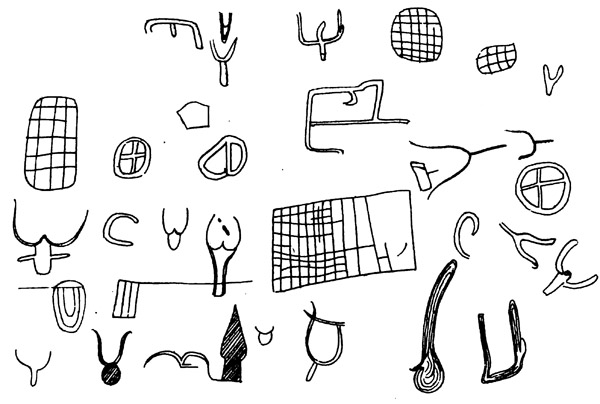
from Moggridge 1869, table I of the engraved Mt. Bego figures, for the first time copied and published (drawings by M. Dieck, a Prussian naturalist and a near relative of Count Bismarck)
About thirty-two miles to the north of Mentone, a town now in the south-east corner of France, is a beautiful pension, at the upper extremity of gorges which rank among the finest in Europe, those of Saorgio and Paganin ; the latter deriving its name from ‘ paga niente,’ i.e. pay nothing, because in the olden time it was included in the territory of Tende, where the tax-gatherer was unknown. This pension is S. Dalmazzo di Tende, and is placed at the junction of two lateral rivers with the Roya. The western of these streams descends from the Laghi delle Meraviglie, which are six hours from the pension.
Accompanied by M. Dieck, an able and intelligent Prussian naturalist and a near relative of Count Bismarck, with a porter and a guide, I left the pension for the highest ‘vacherie‘ in that western valley, four hours distant. One glance at the miserable hovel, occupied, during the short summer, by those in charge of the cattle, sufficed to show that the open air would be far preferable, and instructing the guide how to erect some sort of shelter against the storms, thunder, lightning, hail and rain, which came on every afternoon, we went on to explore. The result may be best blended with that of subsequent days. On our return, we found a tolerable coffee prepared for our reception. It is true that the rain penetrated the roof, but my mackintosh served to fend it off ; and those who are particular might have objected to the wind, which came in from all quarters, but our safety consisted expressly in that the wind did come in from all quarters, one current so neutralising another that there was no draught. On the whole we were well off though standing was out of the question, sitting practicable only under the ridge-pole. We were here at a height of 6000 feet above the sea, and two hours from our work.
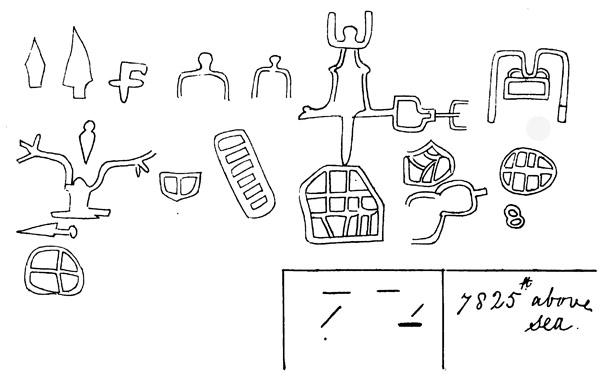
from Moggridge 1869, table II of the engraved Mt. Bego figures, for the first time copied and published (drawings by M. Dieck, a Prussian naturalist and a near relative of Count Bismarck)
From our gíte we passed the next morning through a tortuous valley, exhibiting marked traces of glacier action, until we arrived at an open space, full of small lakes evidently dug out by the ice, and surrounded by mountains of about 10,000 feet. Here we found proofs of the presence of the French in 1793. Passing on to the upper end of this open space, and leaving the river on our right, the rocks were still polished by the extinct glacier up to a height of 8000 ft. above the sea ; and on these rocks so prepared are many hundreds, perhaps thousands, of strange designs, the ‘Meraviglie,’ samples of which I have now the honour to lay before you, believing this to be the first time that they have been copied.
Though provided with ample means for taking rubbings, casts, &c., the weather was so bad that little could be done in that way. I went to work with the pencil, but soon found that M. Dieck was much quicker than myself, and at least as accurate. Therefore, confining myself to the task of finding fresh subjects, I have to acknowledge my obligation to the Prussian for the drawings.
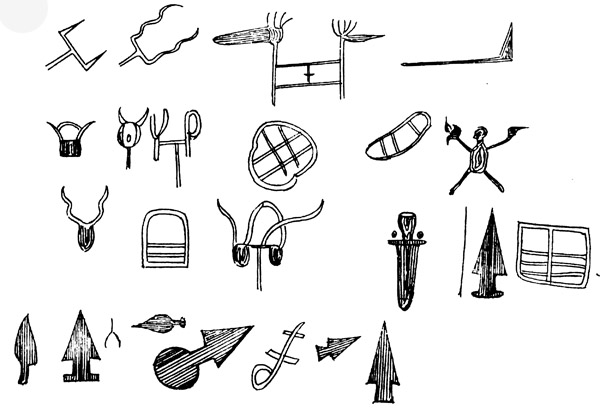
from Moggridge 1869, table III of the engraved Mt. Bego figures, for the first time copied and published (drawings by M. Dieck, a Prussian naturalist and a near relative of Count Bismarck)
I could discover no writing, in the common acceptation of the word. If any meaning is to be attached to these designs they must be read as hieroglyphics. The fact that the figures are frequently repeated and in different combinations, just as our letters are to form words, may accord with the supposition that they have a meaning.
The inscriptions are generally on the horizontal surfaces of the polished rocks (which are mica-slate), sometimes on the sides, never where rope or ladder is needed in order to reach them. They are not carved or cut, but were effected by repeated blows of some bluntly pointed instrument.
The tradition of the country is that they were the work of Hannibal’s soldiers, but I am bound to say that Hannibal, in that country, plays the same role as Caesar, Oliver Cromwell, and his Satanic Majesty in England, to one or other of whom is popularly assigned the authorship of those things which cannot otherwise be accounted for. We have, however, among these designs, the Egyptian symbol for water, and the twisted horn of the antelope, both savouring of Africa. North of Scaraena, at about half-way between the Meraviglie and Nice, is a place where an altogether independent tradition says that the rocks were worked away to widen the path for the passage of the Carthaginian troops.
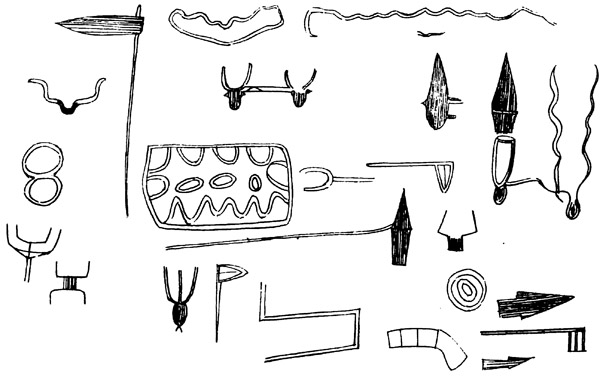
from Moggridge 1869, table IV of the engraved Mt. Bego figures, for the first time copied and published (drawings by M. Dieck, a Prussian naturalist and a near relative of Count Bismarck)
Hannibal, it is believed, passed through a widely different country. After his great victory over the Gallic Celts at the passage of the Rhone, he marched to the north and north-east for a considerable distance. Then, turning southward, he crossed the Alps, probably at the Bernardine; and going south or south-west, found himself in the plains of Italy, where he must have seen between him and the sea the Maritime Alps, much lower than those mountains which he had traversed, and inhabited by the friendly Ligurian Celts, affording a line of march whereby two-thirds of the distance might be saved. He might therefore have sent back, to desire his brother Asdrubal, who commanded one body of his supports, to take the short cut over the lower mountains, the Roman army at Marseilles, which caused him to make that great detour, being withdrawn for the defence of Italy.
In this case the two before-cited traditions might well be true. Another suggestion has been made by a gentleman who passed many years in India, viz. that the Meraviglie may have originated in a singular custom, similar to one which has for ages existed and still exists among the higher mountains, where, when the snow has melted, the natives flock to that lofty region to engrave upon the rocks certain mystic signs; this they regard as a notification to posterity. Some support may be derived for this idea, from the fact that one of the figures (in the upper part of the first plate) is the counterpart of an engraving in an old book in the great library at Turin, where it is called ‘Idol Sarde.’ The inscriptions, too, are obviously not all of the same date. For myself I have no wish to express an opinion one way or the other, but merely to state facts fairly, in the hope that those more competent may arrive at a satisfactory solution as to the question of origin, and possibly obtain a clue to enable them to decipher those strange designs, the MERAVIGLIE.
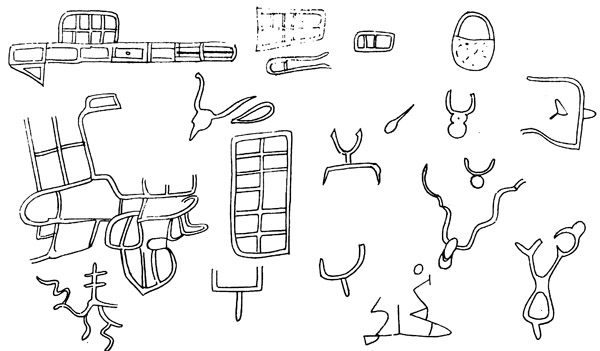
from Moggridge 1869, table V of the engraved Mt. Bego figures, for the first time copied and published (drawings by M. Dieck, a Prussian naturalist and a near relative of Count Bismarck)
Original reference:
Moggridge M. 1869. The Meraviglie, in International Congress of prehistoric Archaeology, transactions of the Third Session, London, 359-362, 5 plates.
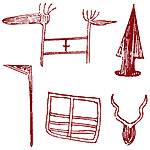














Leave a Reply